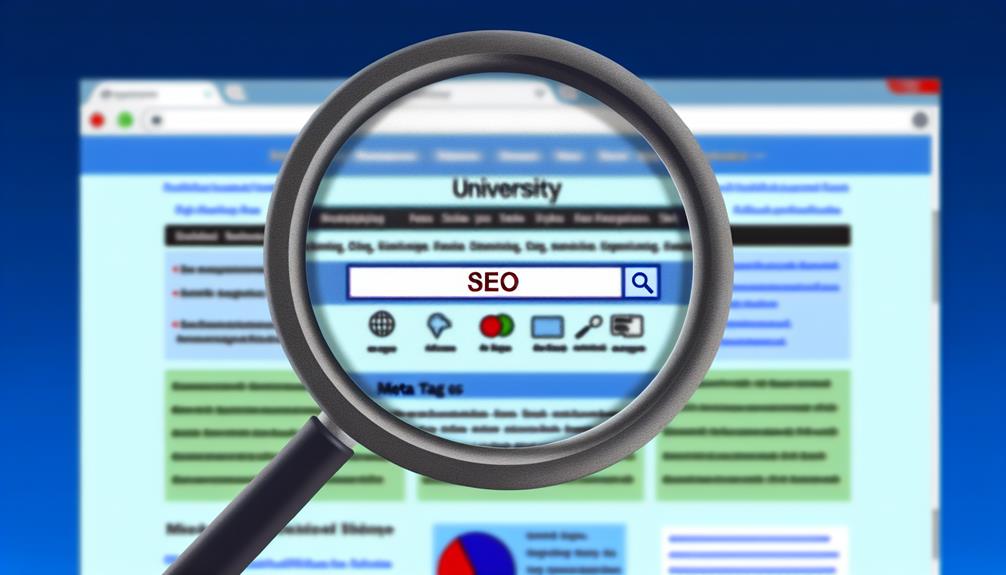Navigating the digital landscape, optimizing your university's website, and increasing its visibility on search engines are critical tasks you can't ignore.
As you delve into the world of On-Page SEO, you'll find that it's not just about stuffing keywords but about strategically placing them, creating compelling meta descriptions, leveraging header tags, and ensuring a swift website loading speed. It's also about the importance of having a mobile-friendly design and the effective use of internal and external links.
However, applying these techniques specifically to higher education websites can be a bit tricky. So, why is it more complex? And, how can you navigate this complexity to increase your site's ranking effectively?
Stick around, and we'll unravel the answers together.
Key Takeaways
- On-page SEO is essential for optimizing individual web pages and improving user experience and visibility.
- Keyword research is crucial for creating high-quality content that connects with prospective students.
- Proper placement of keywords in titles, meta descriptions, and main body is important for website visibility and engagement.
- Optimizing meta descriptions, titles, header tags, and internal and external links can enhance the SEO of higher education websites.
Understanding On-Page SEO

Let's dive right in and unravel the complexities of on-page SEO, essential for optimizing your higher education website for search engines. You're probably wondering, 'What is on-page SEO?' It's the practice of optimizing individual web pages on your site, improving both your site's visibility and user experience.
Your first step is understanding SEO Analytics. It's more than just numbers and graphs; it's about making sense of data and using it to your advantage. SEO Analytics can help you identify what's working and what's not, allowing you to refine your strategies effectively.
Now, let's talk about content quality. You've heard it before: 'Content is king.' But what does it mean? It's about creating relevant, valuable content that engages your audience. High-quality content isn't just well-written; it's also well-researched, original, and provides real value to your readers. It's what keeps them coming back for more.
Importance of Keyword Research
Unearthing the right keywords is a critical step in your on-page SEO journey, as it's these targeted phrases that connect your prospective students with your higher education website. When you comprehend the importance of keyword research, you're better equipped to shape a potent keyword placement strategy. This strategy involves tactfully positioning your chosen keywords in areas like the title, meta description, and main body of your webpage.
But it's not just about keyword placement, it's also about keyword density analysis. This involves assessing the number of times your chosen keywords appear on your page. Too few occurrences, and you mightn't rank well; too many, and you risk being penalized for keyword stuffing. You need to strike a balance.
In essence, effective keyword research is the bedrock of optimizing your website's content. It's the foundation that shapes your content creation, helping you connect with students who are actively seeking the courses and information you provide. So, don't underestimate it. Invest time and resources in keyword research. It's an investment that'll pay dividends in the form of improved website visibility and increased student engagement.
Optimizing Meta Descriptions and Titles

Building on the foundation of effective keyword research, it's crucial to optimize your meta descriptions and titles, as it's these elements that often make the first impression on search engines and potential students. To ace your on-page SEO, you need to nail these two areas effectively.
Firstly, remember meta description length matters. You've got about 155 characters to make your mark. Use them wisely! It's your chance to summarize your page content and lure in potential students. Don't waste space with fluff – every word should serve a purpose.
Secondly, focus on title tag uniqueness. Search engines, like Google, use your title tag to understand what your page is about. It's also the first thing users see in the search results. Make it unique, precise, and relevant. Use your primary keyword, but don't stuff. Keep it natural, engaging, and under 60 characters to ensure it displays fully in search results.
Leveraging Header Tags Effectively
Moving forward, it's essential to understand how to leverage header tags effectively for improving your website's SEO. Header tags, ranging from H1 to H6, serve as signposts that guide readers through your content. But more than that, they're a critical component of SEO, helping search engines understand the structure and content of your pages.
Understanding the tag hierarchy's importance is key. The H1 tag should contain your main topic, while the subsequent tags (H2 to H6) break down the topic into subtopics, following a logical order. This structure makes your content easier to navigate, both for readers and search engines.
Header tag customization is another powerful tool. You can customize these tags to include relevant keywords, further boosting your SEO. But remember, don't force keywords where they don't naturally fit.
Consider these pointers to leverage header tags effectively:
- Understand the importance of tag hierarchy
- Customize header tags with relevant keywords
- Don't overuse keywords in your tags
- Keep your header tags descriptive and concise
- Maintain a logical order in your header tags
Utilizing Internal and External Links

Navigating the complex web of SEO, you'll find that judiciously using internal and external links can significantly boost your site's visibility and credibility. A smart link placement strategy is key to maximizing these benefits.
Internal links, those that point to different pages within your own site, help guide users and search engines to relevant content. They create a network of interrelated content, making your site more navigable and understandable. But it's not just about placing links anywhere. Your strategy should consider the user's journey, placing links where they'll be most useful.
External links, meanwhile, connect your content to other credible sources, enhancing your site's authority in the eyes of search engines. Just make sure the sites you link to are reputable and relevant to your content.
Anchor text optimization is another crucial aspect. This is the clickable text in a hyperlink. Your anchor text should be concise, descriptive, and relevant to the linked page. Avoid generic texts like 'click here'. Instead, use keywords that give users and search engines a clear idea of what they'll find when they follow the link.
Enhancing Website's Loading Speed
Just as optimizing your internal and external links can improve your site's SEO, so can boosting your website's loading speed, making this an essential step in your optimization strategy. A slow-loading website can frustrate users, potentially causing them to leave your page and not return. You don't want that, do you?
For this reason, you should consider using speed monitoring tools. They'll help you to identify any issues that might be slowing down your site, allowing you to fix them promptly.
- You'll feel relief knowing you're providing a seamless user experience.
- You'll be thrilled to see your bounce rate decrease.
- You'll feel a sense of accomplishment as you watch your page rank improve.
- You'll gain confidence knowing you're staying competitive in the digital landscape.
- Lastly, you'll feel satisfied knowing you're maximizing your SEO efforts.
Another crucial factor to enhance your website's loading speed is image optimization. Large, uncompressed images can significantly slow down your site. By compressing them, you can improve your loading speed, without sacrificing image quality. Remember, a fast-loading website isn't just good for SEO, it's good for your users too.
Importance of Mobile-Friendly Design

In today's digital age, it's absolutely essential that your higher education website is mobile-friendly. As more students use smartphones for research, the importance of having a responsive design can't be understated. When you optimize your site's mobile navigation, you're not just making it easier for users to find what they need; you're also boosting your search engine rankings.
Responsive design benefits range from improved user experience to higher conversion rates. When your website adapts smoothly to any screen size, it prevents users from zooming in and out or scrolling horizontally. This hassle-free navigation keeps users on your site longer, increasing the chances of them taking desired actions like filling out application forms or signing up for newsletters.
Mobile navigation optimization is another crucial aspect. A clean, easy-to-use menu can drastically improve the user experience. It's important to ensure that key information, like course details and admission procedures, are easily accessible.
Conclusion
Just like a well-organized library attracts more readers, a well-optimized website draws more visitors. Your higher education website is your digital library.
Use on-page SEO as your librarian, guiding users with keywords, meta descriptions, and effective links.
Make sure it's fast and mobile-friendly, like a library with easy access and quick service.
Remember, an optimized website isn't just about visibility, it's about providing a seamless, user-friendly experience.




